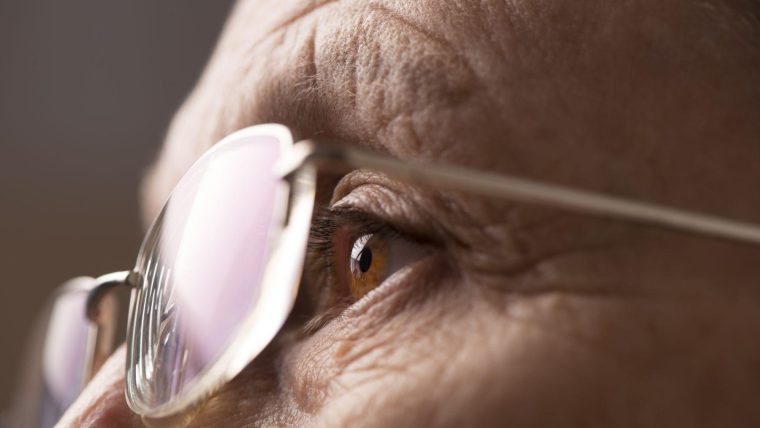Understanding cataracts and improving outcomes for patients
1 June 2021

Around 12 million people worldwide are blind due to cataracts. In the UK, cataract surgery is the most common elective surgical procedure. We’ve invested across a spectrum of work on cataracts – from research investigating how cataracts form in the first place to equipment, simulating cataract surgery.
A cataract is when the lens of the eye becomes progressively opaque, usually over several years.
The cataract means that light rays cannot pass through the lens normally and vision becomes blurry.
Most cataracts are related to age but they can also be present at birth or caused by injury or drugs, such as steroids.
Visual development following cataract surgery in children
Cataract is the leading cause of treatable blindness among children in some developing countries.
Early cataract surgery can help visual development but despite this intervention, some children may still struggle to develop normal vision.

Several reasons are known; if the cataract was only in one eye, the brain will still prefer the other eye, even after surgery.
Also, if there are other problems with the development of the eye or high pressure occurs, vision will not be normal.
One possible reason that has not yet been explored is whether there may be an underdevelopment of the area of sharpest vision - the fovea.
Dr Annegret Dahlmann-Noor and her research team examined this question using a form of imaging called optical coherence tomography.
They looked at the fovea which allows for sharpness in vision, comparing it in children with healthy eyes to children who had undergone cataract surgery.
The team found that indeed the fovea sometimes does not develop fully in those who had the operation. This is the first time this change has been described.
Although cataract surgery can disrupt the development of normal vision, further research is needed to investigate if the same eye developmental issues forming the cataract also cause the underdevelopment of the fovea in children.
Their results were published, with further support from the charity, in the Investigative Ophthalmology and Visual Science.
Investing in equipment and training
Cataract surgery is generally highly successful. But as with all types of surgery, surgical simulators are essential for training surgeons to perform complicated operations with absolute precision.
Thanks to the generous donations to our summer appeal (2019) and support from charitable trusts and foundations, we purchased a new, state-of-the-art surgical simulator for Moorfields Eye Hospital.
This equipment is the very latest model of surgical simulator allowing advances in technology to be available to train surgeons to be even more precise and accurate.
George Saleh, Consultant ophthalmic & oculoplastic surgeon and Dr James Wawrzynski, Registrar ophthalmologist
The surgical simulator ensures Moorfields continues to offer the very best learning environment and remains at the forefront of eye surgery worldwide, benefiting many patients.
Supporting cataracts clinical trials
Cataract surgery is the most commonly performed eye operation, with around half a million operations in the UK each year.
We supported the purchase of important pieces of equipment that were used as part of a clinical trial.
A femtosecond laser, which is used during cataract surgery, allows for some stages to be automated.
In addition, an endothelial cell counter was used to measure the health of a layer of cells at the front of patients’ eyes before and after surgery.
The equipment was used in a large multicentre National Institute for Health (NIHR) clinical trial, the FACT trial.
Led by consultant ophthalmologists, Mr Alex day and Mr Mark Wilkins, this compared the outcomes of standard phacoemulsification (ultrasound) cataract surgery with femtosecond laser assisted cataract surgery.
The trial looked at visual outcomes, complications and patient reported outcomes measures in 785 patients after three months and one year.
The results, which were published in Ophthalmology and the Journal of Cataract and Refractive Surgery, showed that the outcomes of laser-assisted surgery were similar to standard phacoemulsification (ultrasound) cataract surgery, but cost more.
This provided crucial information for the NHS about the cost effectiveness of the different surgery methods.
Understanding the genetics of childhood cataracts
Although there have been fantastic advances in cataract surgery, there is still much to unravel regarding childhood cataracts.
Having a greater understanding of the biology underlying childhood cataracts will undoubtedly also help in the search for different therapeutic options.
Dr Vanita Berry, Professor Michel Michaelides and colleagues have been investigating the genetics of inherited congenital cataracts.
An overarching aim is to see if they can identify common genes in children with cataracts.
From this, they then might be able to find which molecular pathways are disrupted and cause vision loss in these children.
By comparing the genetics of congenital cataracts patients and their disease presentation, the team could characterise a number of novel mutations – genetic variants – implicated in cataract development.

Whole genome sequencing of families with inherited congenital cataracts has revealed some novel disease-causing mutations, including in regulators of cell-to-cell connections and cell biomechanics, which were published in a number of prestigious journals.
For example, in the journal Eye, the team showed that mutations in HSF4 and GJA3 genes can cause autosomal dominant lamellar cataract.
In Ophthalmic Genetics, they also reported a mutation in EPHA2 causing congenital posterior nuclear cataract and later showed that a mutation in LIM2 was implicated in an autosomal dominant pulverulent form of congenital cataracts.
A review of many of their findings has been published in the British Journal of Ophthalmology in 2020.
Looking to the future
Further research is needed to help identify genetic variations associated with a high risk of developing cataract.
This may lead to new strategies for the prevention of cataract or mitigation of the progression of early lens opacity in both children and adults.

